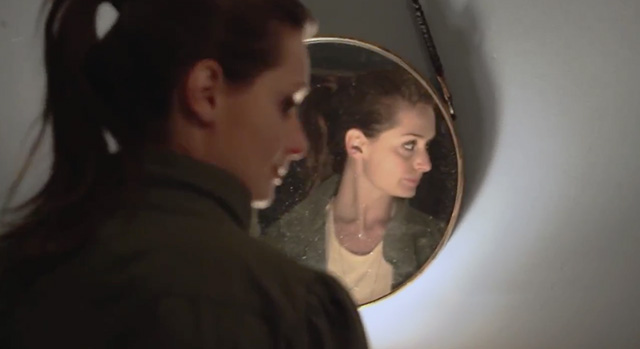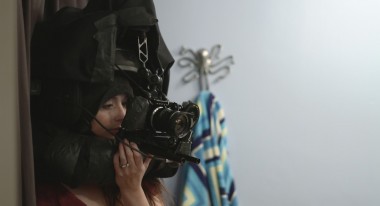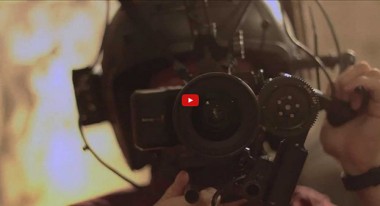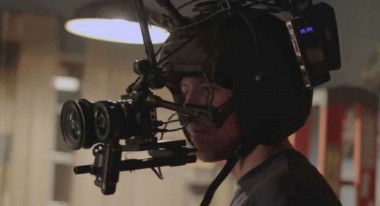 Back to selection
Back to selection
The Week In Cameras
Latest News About the Tools We Use by Michael Murie
Sympathy, Said the Shark: Shooting in POV

Writer, director and editor Devin Lawrence says that when he set out to make Sympathy, Said the Shark he’d already gone through two projects which had stalled out due to lack of financing, so he decided he had to come up with something where “money can no longer be the ultimate road block.” The resulting project was shot in 14 days and primarily in one location, but it was by no means a simple project to make as much of it was shot using a POV rig built around the Blackmagic Pocket Camera.
Lawrence, who works in LA primarily as a writer and editor, first met executive producer Zak Bagans while working on Ghost Adventures for the Travel Channel, which Bagans hosts and executive produces. After developing the idea for Sympathy, Said the Shark, Lawrence approached Bagans with the concept, and he came on board as executive producer of the film. Says Bagans, “We have something very innovative and ground breaking in the way this film was produced and shot.”
The following is an edited interview with Lawrence, Bagans and cinematographer Mark LaFleur:
Filmmaker: Where did the idea for Sympathy, Said the Shark come from?
Lawrence: I’d been thinking about perspective; I feel like we are all imprisoned by our subjective views of the world, whatever’s put in front of us. We’re very reactionary about who we think is good or evil, or right or wrong, when in fact the slightest thing that we don’t know about a person or situation can change our entire opinion. I’ve been playing with how we digest our first-person experience versus an omniscient telling of a story. I had these combinations and I wanted to experiment with how we present the audience with characters that immediately seem one way – where they are extremely normal or where they are extremely insane – and then slowly show these missing pieces that we don’t know could change the viewers outlook on them as we go. That’s what led to the way we shot it, where the majority of the film is told from the explicit POV of the three main characters.
I figured we could create an intimate, visceral view where we are locked into these characters’ perspective and then every time we switch POVs there’s a little overlap, we go back in time just a little bit and see or hear something that the other character missed which gives us an entirely different perspective of what’s going on.
Bagans: Devin and the director of photography Mark’s initial creative process was to shot 80 or 90 percent through this point-of-view camera rig that Mark designed with the Blackmagic Pocket Camera. It was just really amazing because the whole set was free of any production lighting. It was all lit by practicals. And when you go back in time you catch little clues and little visuals that you didn’t see in the other characters point of view. So as a viewer you do start catching this stuff, and it really pulls you into the story.

Filmmaker: The Pocket Camera came out right around the time you were filming. What came first: the rig, the camera or the idea? Or did it all come together as one thing?
Lawrence: I had the idea of shooting it from POVs very early on, before even pitching it, though I still had absolutely no idea how, or if it was even possible to shoot a movie like that. I also wanted to do these very long takes where there are no cuts so that when we are in somebody’s POV there is no jump cutting, there are no drastic changes so you really feel like you are behind those eyes.
I brought on Mark LaFleur the DP; he’s a long time collaborator. We knew that some kind of helmet rig would be the best way to get everything I wanted to see and even possibly have the actors perform with the helmet rig so it would be the least limiting mobility wise for them. If the actors were wearing the rig it meant we needed something as light as possible, and it meant it was going to be hands free. We needed to be able to do remote follow focus on it as well.
I wanted it to feel as real as possible, and Mark wanted it to feel as cinematic as possible and so we had these factors, not to mention that we are a microbudget film so being as innovative and creative as possible is definitely a key factor.
Mark started doing research into cameras and there were a couple of DSLRs out there we were looking at, and then Mark told me about the Blackmagic Pocket Camera, which at that point had just been announced. All we had to go on were the specs, but on paper it looked like the perfect choice. It shot at a very high bit rate, it was extremely light, and it cost only $1,000 bucks. It seemed like a dream come true, but at that point we hadn’t even seen any footage shot on it.
I immediately ordered cameras from two separate places that were extremely back ordered and I was just praying that they got there on time. We were only a couple of months out from shooting by the time one of the cameras actually arrived.
We bought a motorcycle helmet off of Craigslist, drilled a hole in it and hung the camera off of it, and we just ran around to do a test and immediately knew that we were onto something and that this was the right camera. It is extremely light weight and the image is very distinctive; it’s very different from DSLRs; it has a very cinematic, film-like texture to the picture.
Filmmaker: What lenses were you using?
LaFleur: That was another big reason we chose the camera that we chose, because of the Micro-Four Thirds sensor. I had kind of ruled out DSLRs because even with a Canon 7D the depth of field is so shallow and I knew we’d be shooting at fairly large apertures; we ended up shooting the whole thing at f/2 and 2.8. If you shoot that way on a Canon 5D or a 7D it’s so hard to keep things in focus.
Devin wanted things to look very real and to me that super shallow depth of field doesn’t look real; it’s almost too cinematic. It’s not the way our eyes work, it’s not the way people see, so between how light the camera and the Micro-Four Thirds lenses are, and being able to have more depth of field but still shoot at such a large aperture, we were able to have the look we wanted and do most of our lighting with practicals. We did have all kinds of large light sources coming in, mostly through window lighting, but the lighting inside the house was fairly minimal.
Lawrence: We were interested in the variations of the POVs themselves. There’s three different POVs; we have the two guys and the girl and we wanted them to be very distinct, we wanted the POVs to really represent the characters, so we made them slightly different in numerous ways. On top of that, one of the characters is very guarded so he stays very wide and keeps everyone in frame. The other character, you don’t know which direction he’s going to go; he’s on drugs so he’s always looking away from the other characters and moving skittishly with dutch angles, and the girl’s always caught in the middle so she’s always panning back and forth between the two characters. In post we’re altering each POV to give a distinct look where the girl is more sentimental and warm versus the guys who are a little cooler and sterile.
LaFleur: For the character of Church, played by Dominic Bogart, we shot on a Tokina 11-16mm and we kept it as wide as we could, and the adapter I used was a little bit distorted but super super wide. For Justin, played by Lea Coco, we ended up using the same lens but we just pushed in on it so the lens is a little more focused, the depth of field is a little more shallow. For Laura, played by Melinda Cohen, we used the SLR Magic 12mm f/1.6, and the nice thing about that lens is when you put it on the Blackmagic camera it’s a much longer focal length equivalent, and it made it so she was much more focused, not so wide, not distorted and just a little bit prettier. A lot of the time she was closer to people so we got shallower depth of field and made her stuff stand out a lot.
For Church I kept the lens really clean and we really tried to get as many flares in there as possible so it always feels like he’s a little off-kilter; you never really get too settled in, so that was really fun to make separate looks for each of the people.
Filmmaker: Did you end up having the actors wear the rig?
Lawrence: Shooting this film was unlike anything else, and there was a lot of figuring out as it goes. Mark actually wore the POV rig for about 80% of the shot – he could double as the two male actors, and he would wear their wardrobe.
The actors would rehearse the scene and do the blocking and then Mark would go in and learn their blocking and all the hand movements and the gestures, and the actors would be behind him and often steering him through a scene so he could do it as authentic to the character as possible. The actors, even if they weren’t wearing the POV rig, would be right with Mark almost puppeteering him and delivering their lines so it was still a very intimate performance.
Our main actress, Melinda, ended up wearying the POV rig the most of all and shot a lot of her own stuff and became really great at it. Having her wear the rig was a very key reason to keep it as light and well balanced as possible, and you can tell that the actress is wearing the POV rig and shooting her own scenes while still acting with the other cast.

Filmmaker: What was the total weight of the rig?
LaFleur: It was probably around 15 lbs.
Lawrence: There were a couple of days where she wore the POV rig, and we were doing very long takes where they’d have been up to at least five minutes. Acting out scenes that long can be very draining, but when you are basically shooting it yourself that adds a whole other element. But our actors were tremendous, I can’t say enough great things about their performance as well the stamina that they showed on this film.
Filmmaker: How were you monitoring this?
Lawrence: Mark wanted to make sure that we could have remote follow-focus, and we needed an HD wireless transmitter going from the helmet to our video village monitoring system.
It’s mainly shot in one house, and the house is almost a 360 set because we’d have the actors go entirely around the house in a take and we had to clear it of crew and everything.
We had a little room off to the side where we set up our video village and we had our AC, John, who’s six inches from the monitor, riding the follow-focus system with the rest of us huddled around watching as it’s going on.
LaFleur: I was really happy with the way that follow-focus came together. The wireless receiver was in the center of the house, and we had a 200 foot HDMI cable back to the 21″ monitor in the laundry room and that allowed us to have a perfectly clear HD uncompressed signal anywhere the actors walked in the house which gave us a tremendous amount of freedom. We used a Paralinx Arrow wireless transmitter.
Filmmaker: What was the rest of the movie shot on?
Lawrence: The rest of the movie was shot on a Sony F3.
Filmmaker: How long was the development process?
Lawrence: This is actually a very unique process. Before Sympathy Said the Shark I had two larger budget feature scripts I was trying to get together and they were in the $1 million range. They were partially funded, but we couldn’t get the entire funding together so they stalled out and I was getting very frustrated.
I was talking to one of my producers, and we just said, “Money can no longer be the ultimate road block, we just have to make something for whatever we have and we’ve got to make it great.”
At that point I sat down and started thinking about the constraints I would have where we could shoot a movie in one location, very contained, but at the same time it’s got to be different, it’s got to be unique, it’s got to grab you, and that’s what developed the story as well as the POV style, just trying to do something innovative.
The script came together very, very quickly. From the concept to the first draft I’m talking a matter of a few months, though the script continually developed and there were rewrites. We always knew we were making this movie no matter what, and I think that was a really important mentality. It was never the kind of script I was going to shop around or try and sell.
It went from the initial concept to the script to casting within a year, and that’s why it’s hard for me to say when exactly pre-production started because we were always in that mode of, “We are making this movie and we are bringing these pieces together.” It was like a runaway train where it just always kept moving. We really hit high gear probably in October when I went to Zak, and as soon as he got excited about it and came on board it just shot off. We went right into casting and we started filming at the end of December. Two weeks, 14 days, 70 grand and we got a movie
Filmmaker: It was a 14-day shoot?
Lawrence: We had 12 days of principle photography at the house, we were burning about 8 and a half pages per day on set. Then we had two-and-a-half days of flashbacks where we were shooting multiple locations per day. It was a very run-and-gun situation with a very skeleton crew but it turned out absolutely fabulous; the flashbacks are my favorite parts of the movie.
We knew from the start that the only way we were going to make this film for what we had was that it had to be a two-week shoot. That’s also why we shot at the end of December because that is the industry down time where crew, who were was mainly people we’ve known and worked with before, and we could get them at lower rates than usual. A lot of planning and thought went into making this at the budget that we had.
Filmmaker: What did you edit this on?
Lawrence: Final Cut Pro 7.
Filmmaker: And Devin, you did the editing?
Lawrence: Yes, which helps a number of factors including money and time. After really honing my editing skills on Ghost Adventures, I put this film together relatively fast. We had our first cut five weeks into post production.
Because of the way we shot it with the POV style, there are a lot of these very long takes, so in a way it happily limited me in post because the shots that I had to use all had to go linear, and they were only a certain amount of takes.
I think on average we would shoot 10 takes of each shot. Within that it’s very crucial to choose the right shot because everything has to come together with performance, camera and sound. Mark and I went through beforehand and planned out specific hidden cut points to save ourselves where on certain looks and whip pans we could hide cuts and really keep it fluid and seamless at the same time.
LaFleur: The great thing for me was Devin being able to get those cut points in the script. We had multiple meetings about where can we hide a cut? Not only did it make it easier for the actors, it made the scene a little bit shorter and easier for me because knowing all the blocking was really tricky. It also meant that we were able to adjust the lighting. It definitely made my gaffer feel a hell of a lot better when we were able to sneak in a couple of extra lights and tweak things. Coming away from the screening I’m just so happy because you’re watching these raw takes, and I know where the cuts are. And the continuity is there. I don’t see the lighting changes from room to room, and I know how much we tweaked things, so that makes me really happy.

